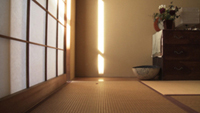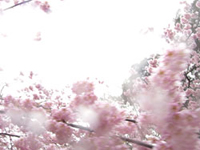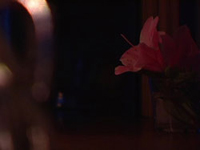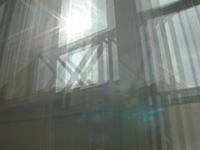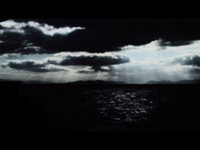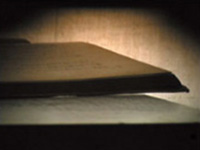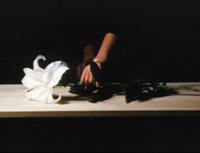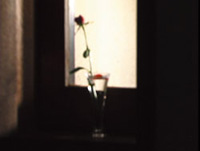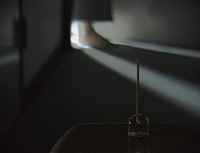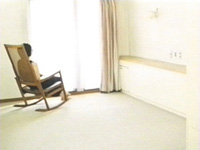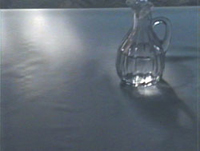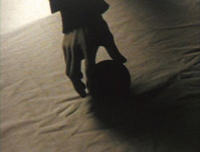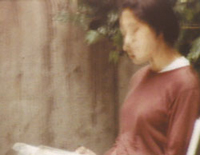Faraway window
2023 / 4K video / 24min
The focus shifts very slowly from the room’s interior to the outside. During this long and steady journey of the gaze, the sounds and sceneries of the indoor and outdoor settings blend into each other, until it becomes difficult to discern which is which.

Hydrangea
2016 / HDV / 11min 30sec
Dahlia
2009 / HDV / 13min 18sec
This work was made as part of the omnibus movie ”Seeing.”
Shot frame by frame in intervals of one second, the video captures the changing light in a room across a timespan from daybreak until nightfall. Through the gradual transition of light and changing position of the camera, time and space are distorted and entangled.
About ‘Seeing’
“Filmmaker Matsumoto Toshio, a pioneer of experimental film in Japan and an advocate of Neo-Documentarism since the 1960s, conceived and structured this omnibus film, directed by six experimental filmmakers. Based on the theme of ‘seeing’, proposed by Matsumoto, the six directors approach the subject from varying individual perspective and develop their own unique images. The film addresses fundamental questions: What does it mean to ‘see’ things, and What does it mean to ‘make films’?”
(from the official catalog of Yamagata International Documentary Film Festival 2009)
Seeing (2009/HDV/95min/6film omnibus)
Planning, Structure: MATSUMOTO Toshio
Producer: SANO Masumi (Sano Gallery)
Director: KATO Itaru / KANO Shiho / MAEDA Shinjiro / INAGAKI Kanako / OKUNO Kunitoshi / OKI Hiroyuki
Shinonome Omogo Ishizuchi
2008 / DV / 15min
“This work was commissioned by the Kuma Museum of Art (Ehime Prefecture). It revolves around scenery in Ehime Prefecture and Matsuyama-born film director Itami Mansaku. It begins in Shinonome, the setting of a short story by poet Nakamura Kusatao which is thought to be a depiction of his friendship with Mansaku, and follows Mansaku as he return to Matsuyama from Kyoto where he has become a film director and visits Omogo and Ishizuchi.”
(from the catalog of Image Forum Festival 2010)
feinfügig... unüberholbar...
2007 / DV / 19min
sound:Yurihito WATANABE
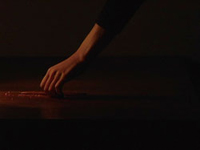
Candle
2007 / DV / 7min
Distribution:MIACA (Japan)
Atelier
2006 / DV / 7min
Collection:Tokyo Metropolitan Museum of Photography (Japan)
Distribution:MIACA (Japan)
A studio contains only the camera in a corner of the room. The filmmaker is absent. While rotating, the camera alternates between close-ups and wide angle shots of the studio. (S.K.)
Wave
2005 / DV / 15min
Distribution:MIACA (Japan), Collectif Jeune Cinéma (France)
Numinous tracings of beautiful light on the sea, augmented by the artifice of video. (S.K.)
a book
2004 / DV / 4min
The camera examines an old book about cinema through a small hole similar to a camera obscura. The camera repeats a zoom in/out, analogous to the movement of turning pages, but the text remains illegible. (S.K.)
Lily in the Glass
2003 / 16mm / 6min
Distribution:Collectif Jeune Cinéma (France)
A letter no one can read, a character whose face cannot be seen, a room without dimensions...remnants of a narrative that have lost their way, tenuously connected with each other by the flashes between cuts. These flashes are a disorder inherent to the movement of film through a camera. They are also traces (reflections) of the essence of the lens (glass), the existence of which is unseen. (S.K.)
Rosecolored Flower
2002 / DV / 12min
Distribution:MIACA (Japan), LIMA (Netherlands)
In a somber room, there's a flower at a far window. A hidden movement in this video transforms with the course of time into turns and reverses of the inside and the outside of the room, day and night or light and darkness. However, the flower, the pivot of the movement, collapses its own exsistance as one could hardly tell even the color. Here we loose the core we rely on. (S.K.)
“A rose in a glass vase on the windowsill. Soft Vermeer-like light falling into the dusky room, and playing through the crystal-clear water. Most of all, this yields a ‘beautiful’ picture, well-framed, wonderful colours, tone and shades. Throughout the video, the camera behaves like the eye of someone who wants to drink in this beauty to his heart's content. Concentration and a zen-like focus on the aesthetic experience makes the components unfold. Change of light, shifts of colour, blurred spots, red-and-black counterpoints and more of that kind, build up an intensity that culminates in the viewer's literally being sucked into the image. Or rather, into one single spot which, as a component aspect, probably contains all the beauty of the whole - analogous to the Proustian yellow spot on a wall in Vermeer's 'View on Delft'. Through this wormhole, our gaze disappears, to be chastened and thereby to adopt a totally different perspective.” (Vinken en Van Kampen)
(from the online catalogue Netherlands Media Art Institute/LIMA)
Floating Leaf
2002 / DV / 1min
The leaf is floating slowly in the dark with the song on the radio out of tune. (S.K.)
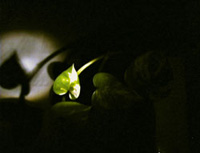
Incense
2002 / DV / 6min
Collection:The National Museum of Art, Osaka (Japan), Tokyo Polytechnic University Library (Japan)
Distribution:MIACA (Japan), LIMA (Netherlands)
The smoke of an incense stick hangs in the air of a dark room. When observing the scene in which virtually nothing happens for a while, the viewer notices that the smoke moves in ways as it wouldn’t move in reality, while the subtle play of light and shadow suggest that there is “something” moving in the darkness. Illustrated by way of filming and editing is a space that can only exist in imagery, expressing the presence of visible things and invisible things in a setting of multiple overlapping timeframes. (S.K.)
“Looking closely at a seventeenth-century still life, you will often see how the surroundings of the tableau, which are actually outside the scope of the painting, are nevertheless part of the image. The reflection of a light source in the scale of a fish; a space beyond our field of vision, caught by a mirror on the wall. These are hints that unemphatically enter into our perception, thus creating a suggestion of a larger world than we can see in the foreground. For her video still lifes, Shiho Kano makes use of timeless objects from everyday life: an apple, a rocking chair, and in this case a stick of incense in a glass burner. The stick keeps on burning motionlessly, with so much concentration that you can almost smell its fragrance. Then a scene begins to unfold around it. With light and shadow, time and sound, Kano sketches a room, a door, a space behind the door, and the presence of a human being. Of all these elements, the camera and our eyes only register the traces they leave, just out of focus. Incense concentrates on the shadowy transition between perception and understanding, where meaning is newly born and can still take on all kinds of shapes.” (Vinken en Van Kampen)
(from the online catalogue Netherlands Media Art Institute/LIMA)
Rocking Chair
2000 / 16mm / 13min
Collection:Tokyo Polytechnic University Library (Japan)
Distribution:Canyon Cinema (USA), Collectif Jeune Cinéma (France)
Human eye adjusts the brightness of the light automatically, but Camera eye can control the brightness freely. Camera eye can see the darkness in the light of day, and can turn the dusk into the morning sunshine. When the white room is getting darker and lighter, you surely witness that's form is sublimated. (S.K.)
White Tablecloth
2000 / DV / 7min 30sec
Collection:Tokyo Polytechnic University Library (Japan)
While the spot of water soaked into the tablecloth has disappeared holly -7min 30sec-, the spot repeats contracting and expanding like a surf. Technically, I recomposed the arrangement of time by editing, and piled scenes several times. In this film, the physical and real time of evaporation coexists with the operated time in the film, The aftertaste and the blank are also important matters for this film. (S.K.)
STILL
1999 / Single-8 / 15min
Collection:Tokyo Polytechnic University Library (Japan)
Action of the character in the film is expressed by monochromatic still pictures, in fine, time is in cut state. Though color scenes inserted in the film have flowing time, we can't easily recognize that the scene is moving, because of the fixed shoot. I expressed the fixed time of still pictures, and the eternity and the timelessness, in this film. (The eternal flow of time in fixed scene, or time which is kept stopping.) (S.K.)
Landscape
1998 / Single-8 / 13min
Collection:Tokyo Polytechnic University Library (Japan)
You can see the woman sitting still and the landscape in turn. In this film, the character is not the heroine, and is equated with the landscape.As the subject is equated with the existence of a film too, the difference of time each having is presented in this film. (S.K.)

